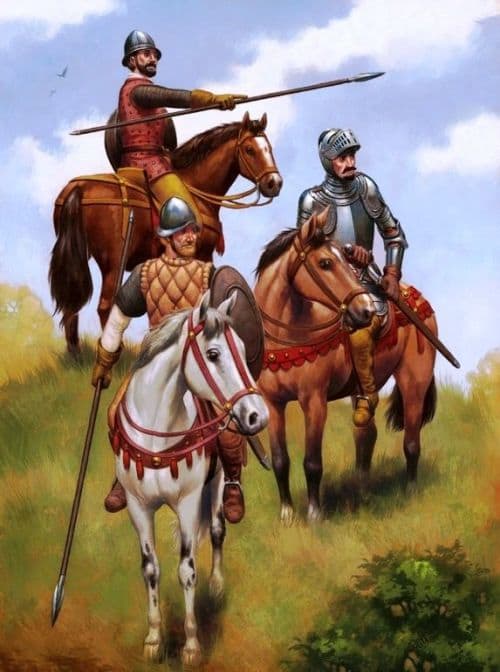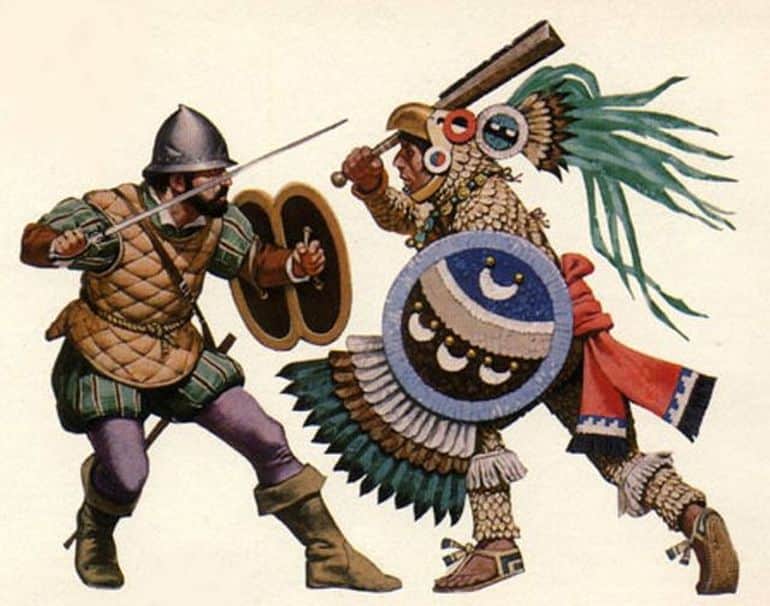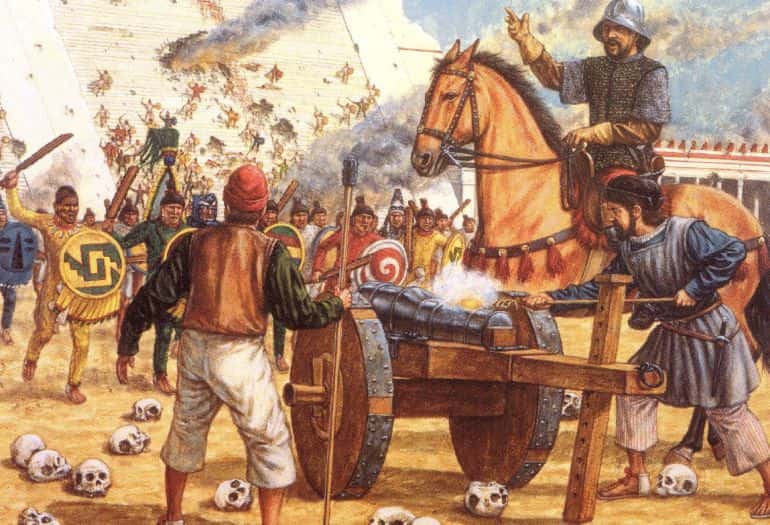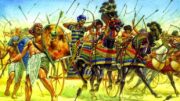Introduction
When we talk of the Conquistador, the subjective discussion tends to either take a damning route or present an idealizing status. But beyond the controversial colonial heritage left behind by these medieval groups of swashbucklers, there is no denying the military resourcefulness of the Spanish Conquistadors (or plural Conquistadores; the word conquistador in Spanish means ‘he who conquers’).
Incredibly enough, their fascinating military impact was felt in a very brief age that barely spanned three decades till the mid-16th century. So, without further ado, let us apply the objective lens of history and take a gander at the origins and military of the Spanish Conquistadors (or Spanish Conquerors).
Contents
- Introduction
- The Origins of The Conquistadors
- The Factor of Gold
- The ‘Self-Confidence’ of The Rag-Tag Conquerors
- The Misconception About Gunpowder in the Americas
- The Advantage of Horses
- The Power of Conquistador Heavy Cavalry
- Conquistador Armor Styles and Their Practicality
- The ‘Unsung’ Light Cavalry
- The Effective Sword-And-Buckler Men
- The Devastating Artillery of Conquistadors
- Honorable Mention – Battle of Cajamarca
The Origins of The Conquistadors

Regardless of their enviable feats and egregious plundering, the question can naturally be raised – who were these Spanish Conquistadors? Were they reckless adventurers or simply paid mercenaries of the Spanish crown?
Well, the answer is far more simple – they were soldiers, more specifically disfranchised, professional soldiers. Essentially, most of them were the remnants of the veritable standing army of 16th century Spain – men who were unexpectedly unemployed by the periodic lulls in the Italian Wars, and consequently, motivated men who restlessly craved more riches (and sometimes glory).
Their opportunity came in the form of the Age of Exploration, which paved the way (route) to the Americas. And thus some of the professional (but disfranchised) soldiers banded together to form their own companies and set out in mostly self-financed, small expeditions to not only brave the sea, the weather, the jungles, and the diseases, but also to battle foreign cultures hitherto unknown to them.
Interestingly enough, while popular history tends to represent the romanticized riches accumulated by these Spanish Conquistadors, the truth is that most of the adventurers were relegated in favor of direct Spanish intervention in the Americas (once its jaw-dropping resources were discovered).
This essentially allowed the crown and its government to take over the revenues generated by the newly conquered lands. Like a domino effect, the remaining Conquistadors were rather forced to make more westward forays into the ‘New World’.
The Factor of Gold

Talking of riches and revenues, it would be an understatement to say that the expeditions undertaken by the Conquistadors were simply profitable ventures. As later 17th-century Italian military commander and theorist, Raimondo, Count of Montecúccoli, famously said – “For war, you need three things: 1. Money. 2. Money. 3. Money.”
To that end, the early 16th-century Spanish crown was severely depleting its coffers in the war (Italian Wars) against the French who had twice the population and far more resources at their disposal.
Furthermore, the Spaniards had to rely on battle-hardened professionals and mercenaries (backed by well-trained citizen militia) who could counter the powerful albeit slightly feudal military machine of France (under the House of Valois).
But the predicament, as we mentioned before, related to the availability of money – since professional soldiers needed to be paid (often in a timely fashion), while costs were also stretched by advancements in military technology, like cannon foundries and gunsmith factories.
The unexpected solution came forth from the exploits of the Spanish Conquistadors in the various realms across the Americas. Just to provide a context (as sourced from The Conquistadores By Terence Wise), gold in itself was a rare metal in contemporary Europe, with scholarly estimates suggesting a measly figure of 88 tons for the entire store of gold in 15th-century Europe (that could be easily made into a small 6x6x6 ft cube).
By circa 1560 AD, Spain alone accounted for 99 tons of gold shipped from the New World, and the crown had a virtual monopoly on this ritzy route across the Atlantic. Shifting our focus on the famous Spanish Conquistadors, Francisco Pizarro was possibly able to take hold of a whopping $6,700,000 in gold and silver from the Inca, while his contemporary (and second cousin) Hernán Cortés possibly snatched away around $6,300,000 in gold from the Aztecs (though much of it was lost during his escape from Tenochtitlan).
So in some ways, these soldiers/warlords in distant lands with their newfound wealth could effectively aid the Spanish crown in its wars, in stark contrast to many quibbling European bankers.
Although, as we mentioned before, the Conquistadors themselves couldn’t take advantage of their riches (and political autonomy) for long, with the government methodically replacing them with the ‘services’ of royal appointees, lawyers, clerics, planters, and even mining experts – most of whom were deliberately transferred across the Atlantic to the ‘New World’.
The ‘Self-Confidence’ of The Rag-Tag Conquerors

But beyond gold and adventurous spirit, it was the sheer motivation of the Spanish Conquistadors that fueled their military successes (often against overwhelming odds) in the Americas. The question can be asked – how did they get such zeal and impulse, especially in the context of operating in what they knew to be the ‘frontiers of the known world’, far away from their home nation?
Well, the answer once again boils down to the Italian Wars, comprising a series of encounters from 1494 to 1559 AD. Some historians consider these conflicts as the ‘momentous’ bridge between the medieval and modern eras of military innovations in both technology and tactics. Moreover, these engagements were preceded by the Reconquista of the 15th century, where well-drilled citizen-soldiers formed the backbone of the reorganized Spanish army that defeated the Moors.
In essence, these battles were the crucibles that forged the professionalism and ruthlessness of the 16th-century Spanish army – when Spain reached its peak. Unsurprisingly, many of the participants in these decade-old wars were grizzled veterans, who according to historian Terence Wise, “were not only unbeatable but also knew they were unbeatable.”
Thus we can always assume that there was a certain element of arrogance in the way the Conquistadors infiltrated the New World with their paltry numbers (for example, Pizarro just had 106 infantrymen and 62 cavalrymen, when he invaded Peru).
On the other hand, there were also the practical limitations of their expeditions (like money and available volunteers) that didn’t allow these initially disfranchised companies to recruit more men or invest in more military equipment. Simply put, while being audacious and self-confident, the Spanish Conquistadors were also tempered by years of valuable experience in both gritty warfare and manageable logistics.
The Misconception About Gunpowder in the Americas

At times, it has been argued that while the Spanish Conquistadors were faced with chronic manpower shortages, they had their advantages in gunpowder and crossbows – technologies that were not yet available to the Mesoamericans and the Inca. Now theoretically, this hypothesis does sound credible enough but practicality suggests otherwise.
As historian Terence Wise noted, the early 16th-century arquebus, while being a handy weapon in the open battlefields of Europe against other approaching formations, also proved its unwieldiness in the cramped jungles of Yucatan against foes indulging in unconventional, guerrilla tactics.
To that end, given its bulky proportions, the gun needed to have a rest for the barrel end, along with a lighted match for ignition. The latter had its predicament in the humid weather of the Americas. Thus many of these firing weapons, in spite of their devastating effect, were rendered cumbersome in intense and rapid skirmish scenarios – when soldiers simply didn’t possess the time to prime and aim their guns.
Similarly, the crossbow, in spite of its armor-penetrating power, was slow to reload – essentially making it ineffectual in the face of mostly unarmored yet numerically superior opponents. Furthermore, we should also consider how many of these ‘advanced’ weapons became unserviceable (after just weeks) due to the climate factor.
And the predicament for the Spanish Conquistadors was rather exacerbated by the lack of ammunition replenishment. Fortunately, for Cortés, his native Texcoco allies could furnish thousands of copper bolt-heads tailored to crossbows – and possibly they were of better quality than their European counterparts.
The Advantage of Horses

Consequently, the query still hangs in the air – how were the Spanish Conquistadors militarily successful in the Americas in spite of the relative ineffectiveness of their preferred weapons (and that too against overwhelming numbers)?
The answer perhaps pertains to an often-overlooked factor – the advantage of horses and the related cavalry tradition. Simply put, the Native Americans of Mesoamerica and Peru had never encountered horses before their contact with the Spaniards. In many ways, they perceived the initial cavalrymen of the Conquistadors as ‘beastly’ entities with a supernatural air.
For example, in The Broken Spears: The Aztec Account of the Conquest of Mexico (comprising translated selections of Nahuatl-language accounts of the Spanish conquest of the Aztec Empire by eminent anthropologist and historian Miguel León-Portilla), the Aztecs called the horses ‘stags’. The following excerpt (sourced from The Conquistadores By Terence Wise) sort of points to their awe when it came to these animals –
These stags snort and bellow. They sweat a very great deal, the sweat pours from their bodies as streams. The foam from their muzzles drips into the ground. It spills out in fat drops, like lather of amole (a native plant used for making soap).
They make a loud noise when they run; they make a great din as if stones were raining on the earth. Then the ground is pitted and scarred where they set down their hooves. It opens wherever their hooves touch it.
The Power of Conquistador Heavy Cavalry

As we fleetingly mentioned in the earlier entry, with horses came the long equestrian tradition of trained cavalrymen – an incredible tactical scope that was totally alien to the Aztecs. So, the Aztecs (and other Mesoamerican factions), in spite of their martial prowess, were bereft of the advantage of the hard-hitting cavalryman, the historical equivalent of armored vehicles.
Now from the 16th-century European perspective, the shock cavalry was almost an anachronistic military arm, especially with the development of pike formations and gunpowder technology. But the situation in the Americas was significantly different, with the heavy cavalry detachments of the Conquistadors not only having the convenience of surprise (over their foes) but also the tactical advantages of both power and speed.
Essentially, the impetus of an armored mounted warrior, generated by his charge momentum and downward angle of weapon thrust, put him in a far superior position over an infantryman – more so over an infantryman who had no previous notion of how to counter such tactics.
The impact of these ‘beasts’ also translated into psychological episodes where a few numbers of superbly-drilled Spanish horsemen (with their conspicuous attires, shrill bells, and headlong charges) changed the tide of battles by wrecking the very morale of the Aztecs.
Conquistador Armor Styles and Their Practicality

Talking of armor, the brief yet dynamic Age of Conquistadors coincided with the apical stage of armorer art, while the Italian Wars brought forth, along with its tactical innovations and military technologies, the best creations (and even fusions) of both Italian and German armor styles. Suffice it to say, some of such superb quality armor was prevalent in the ranks of the captains and heavy cavalry forces of Conquistador companies.
For instance, the richer horsemen, in their initial campaigns, tended to wear a ‘three-quarter’ armor comprising a closed-variety helmet, sturdy yet decorated cuirass, arm guards and gauntlets, and leg defenses. Overall, such armor could weigh over 60 lbs, but its design and bulk were streamlined to be evenly distributed over the body of the wearer.
But in spite of its 16th-century bells and whistles, the armor couldn’t stop the wearer from feeling hot and baked under the tropical sun of the Yucatan peninsula. On the other hand, the tropical rain tended to rust such fine specimens, thus rendering them brittle and useless. So, practicality triumphed style, and the Spaniards soon began to adopt a mishmash of local attires and their own armor segments – which resulted in some unique overlaps.
For example, some of the Spanish Conquistadors wore fiber jackets stuffed with cotton. These locally-inspired protective gear were further hardened by soaking them in brine, which offered adequate protection against arrows. The ‘synergetic’ ensemble was completed with heavy helmets and local hemp sandals that replaced the heavy leather boots.
The ‘Unsung’ Light Cavalry

The cultural fabric of Mesoamerica and Peru was decisively altered by the arrival of the Spanish. But as aficionados of history, we should also note that medieval Spain had its own conquerors in the form of the Moors – and they, in turn, influenced many of the cultural and military aspects of the Spaniards.
One pertinent example would relate to the jinetes, lighter (and faster) cavalrymen who were often used to outmaneuver the relatively immobile formations of pikemen and arquebusiers. Such horsemen not only opted for light armor but were also trained in agile riding methods (a la jineta) tailored to circumventing and baffling enemy formations.
Unsurprisingly, these jinete-type horsemen employed by the Spanish Conquistador companies also proved to be useful in the jungles of Yucatan – by virtue of their zig-zag maneuvering, capacity for mounting rapid charges, ability to speedily retreat, and expertise in fast scouting.
They mostly wore open helmets, simple cuirasses, and an assortment of limb guards usually made of lighter mail (and sometimes overlapping plates), while carrying small leather-covered wooden (or iron) bucklers. But their potent offensive weapon pertained to the lanza jineta, a 9-12 ft long lance with a thin cross-section and a diamond-shaped metalhead.
The Effective Sword-And-Buckler Men

However, when it came to pure numbers of the Spanish Conquistadors, there is a high possibility that the majority of them were the sword-and-buckler men, better known as rodeleros (‘shield bearers’) in Spanish – but the term itself could also pertain to larger shields. And surprisingly enough, in spite of the development of gunpowder weaponry in 16th-century Europe, these sword-and-buckler men maintained their niche in battlefields by effectively countering the pikes in melee combat scenarios.
In essence, they sort of bridged the gap between heavy and light infantry, and their protective gear rather mirrored this tactical overlap. To that end, as historian Terence Wise noted, most rodeleros possibly opted for morion-type helmets for better perspective and studded brigandine-type armor for ease of movement (sometimes replaced with plate-reinforced jackets and simple leather jerkins).
But it was the combination of the offensive weapon in the form of straight Spanish steel swords (many of the famed Toledo variety) and their swordsmanship that gave the Conquistador rodeleros a literal ‘edge’ over the native warriors of Mesoamerica.
Now pertaining to the latter, while the veteran Aztec warriors tended to be well-trained in the use of macuahuitl – carved of hardwood and then embedded with obsidian razor blades, these heavy weapons were mostly designed for stunning the enemy. Furthermore, given their general bulkiness, the angle of attack/slashing had to be from the overhead position, thus requiring immense strength and time to wield them effectively (which Aztecs did against other native factions).
But the Conquistador rodeleros, many of whom were experts in the art of fencing, could take advantage of the relative slowness of the foe (along with the lightness of their swords) to deftly lunge and precisely aim for the vitals – which the sharp Toledo steel could do with aplomb, especially through cotton armor preferred by the Aztecs.
However, this is just a hypothetically presented simple scenario. In practical circumstances, when faced with overwhelming numbers, one could imagine the well-drilled rodeleros making use of their grit and determination (rather than fencing skills) to hold the lines, while the cavalry, gunners, and artillery played their respective crucial roles.
The Devastating Artillery of Conquistadors

Another scope that is often overlooked when it comes to the conquests of the Conquistadors pertains to the effect of the cannons. Now while being plagued by the similar predicaments faced by other gunpowder weapons (like arquebuses) in humid, dense vegetation conditions, the canon had the undeniable advantage of its sheer impact.
Coupled with its low numbers (thus maintaining logistical value) and availability of native porters, the cannon could land its devastating shots, especially since the Conquistadors had to deal with large groups of enemies (which translated to ‘big’ targets from artillery fire).
Furthermore, beyond just the brutal physical element of artillery barrages, we must also consider the distressing psychological impact of these thunderous shots on the Mesoamericans – people who had no previous experience of the sights and sounds of gunpowder-based warfare. This ‘shock-and-awe’ factor is aptly presented in the following passage from The Broken Spears (sourced from The Conquistadores By Terence Wise) –
Then the Spanish fired one of their cannons, and this caused great confusion in the city. The people scattered in every direction; they fled without rhyme or reason; they ran off as if they were being pursued. It was as if they had eaten the mushrooms that confuse the mind, or had seen some dreadful apparition. They were all overcome with terror, as of their hearts had fainted. And when night fell, the panic spread through the city and their fears would not let them sleep.
Honorable Mention – Battle of Cajamarca

Both Mexico and Peru were the major focal points of Conquistador military adventures. Pertaining to the latter country, the Battle of Cajamarca (taking place on November 16, 1532 AD) is sometimes counted among one of those aforementioned victories for the Spaniards, who won against overwhelming odds.
The fascinating military encounter in itself pitched around 168 Conquistadors (who only had 12 arquebuses and 4 cannons among them) under Francisco Pizarro’s command, against 3,000 to 8,000 lightly armed guards of the Inca Emperor Atahualpa.
However, beyond numbers, the battle is notable for the fact that was the very first time that most Incas were witness to the destructive and ‘noisy’ power of gunpowder.
The incident started with the Spaniards arriving and concealing themselves within the deserted buildings close to the great plaza of Cajamarca. It is said that some of the Spanish Conquistadors, knowing about their gravely outnumbered status, even urinated in their breeches out of sheer fear. In any case, a procession of around seven thousand Incas accompanying Atahualpa arrived later and made their way safely into the town’s square.
According to accounts, they were mostly attendants of the emperor who donned their richly attired clothes and ceremonial arms of small axes and lassos. The two leaders even met with each other. But things apparently turned sour after the Spaniards tried to convince Atahualpa of their superior religion, and even insultingly (though possibly unintentionally) poured out the ceremonial chicha offered to them in a golden cup.
The confusion in semantics further aggravated the Inca emperor, who supposedly yelled ‘if you disrespect me, I will also disrespect you’. Spurred by this seemingly furious tone, the shaken conquistadors fell back to their positions and opened fire at the vulnerable mass of Incas.
This cacophonous effect shocked the lightly-armed attendants who were not familiar with gunpowder. The Spanish forces took advantage of their state of bewilderment and charged through the Inca ranks with only 62 horsemen. With their bells ringing, accompanied by the sound of boisterous gunfire, the cavalry rushed forth and surrounded Atahualpa’s retinue.
After maiming and killing many of the emperor’s personal attendants, Pizarro finally captured the Inca ruler from his litter and thus started his conquest of an empire stretching over 2 million sq km – with just around two hundred soldiers. As for the Battle of Cajamarca itself, the Inca side suffered over 2,000 casualties, while the Spanish forces probably had less than five injuries (or deaths).
Featured Image: “1559 Landing of Tristan de Luna at Pensacola.” Herbert Rudeen, 1959
Book References: The Conquistadores (By Terence Wise) / The Broken Spears (By Miguel León-Portilla) / The Conquistador 1492-1550 (By John Pohl)
Online Sources: Britannica / BBC / HowtoPeru
And in case we have not attributed or misattributed any image, artwork, or photograph, we apologize in advance. Please let us know via the ‘Contact Us’ link, provided both above the top bar and at the bottom bar of the page.





Be the first to comment on "Conquistadors: The Remarkable Spanish Warriors and Adventurers"